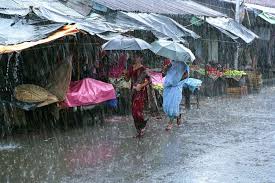As Rains Approach, Are India's Concrete Jungles Ready? The Perennial Challenge of Urban Flooding
Editor
Jun 21, 2025
min read
4 views

With the 2025 monsoon predicted to be 'above normal' and prone to extreme downpours, India's burgeoning cities are once again on high alert for urban flooding. The annual spectacle of waterlogged streets, submerged vehicles, and crippled infrastructure has become a grim reality for metropolises like Mumbai, Chennai, and Bengaluru. While civic bodies claim to be prepared, experts argue that decades of unplanned urbanization, encroachment on natural drainage systems, and outdated infrastructure require a radical overhaul, not just pre-monsoon patchwork.
The problem is systemic. Rapid urbanization has transformed permeable surfaces like soil and wetlands into impermeable concrete and asphalt. This prevents rainwater from seeping into the ground, drastically increasing surface runoff. Existing drainage systems, many designed decades ago, are simply unable to cope with the volume and intensity of modern rainfall, which climate change has exacerbated. "Our drains in cities like Bengaluru were designed for rainwater but are forced to carry nearly 2000 MLD of sewage daily. They are choked with silt and garbage, and their carrying capacity is severely compromised," notes a report by the Centre for Science and Environment (CSE).
In response to these recurring crises, some cities are turning to technology. Mumbai's Brihanmumbai Municipal Corporation (BMC), in collaboration with IIT Bombay, has enhanced its Integrated Flood Warning System (IFLOWS-Mumbai). This system uses real-time rainfall data, tidal information, and drainage models to simulate flood scenarios and issue timely alerts. "During the early monsoon, the system helped us preemptively deploy dewatering pumps and manage traffic, significantly reducing response time," a senior BMC official stated. Similarly, the Greater Chennai Corporation (GCC) is leveraging digital twin technology, creating a virtual replica of the city to simulate water flow and identify potential flood hotspots, allowing for targeted interventions.
Despite these technological strides, the core issues remain. The National Disaster Management Authority (NDMA) has repeatedly emphasized a proactive approach focusing on mitigation. The central government's AMRUT 2.0 (Atal Mission for Rejuvenation and Urban Transformation) scheme includes provisions for strengthening drainage systems and developing water bodies. However, implementation at the municipal level is often slow and fraught with challenges, including lack of funds, political will, and inter-agency coordination. "Water is a state subject, and drainage falls under local urban bodies. This fragmentation of responsibility often leads to delays and a lack of integrated planning," said a former member of the NDMA.
Disaster response forces are preparing for the inevitable. The National Disaster Response Force (NDRF) has designated specialized teams for urban flood rescue. For the 2025 season, teams have been pre-deployed in high-risk urban centers like Rajkot, Ahmedabad, and Surat. These teams are trained in collapsed structure search and rescue and operating in submerged urban landscapes. In Uttarakhand, which is prone to flash floods and landslides, Chief Minister Pushkar Singh Dhami recently chaired a 'Monsoon-2025 Preparedness workshop', stressing the need to identify and secure vulnerable areas and establish better coordination between the SDRF, NDRF, and other agencies.
The solution, experts agree, lies in a multi-pronged strategy. This includes the strict protection and rejuvenation of urban water bodies like lakes and wetlands, which act as natural sponges. It requires the mandatory implementation of rainwater harvesting in all new constructions and the retrofitting of old ones. It also demands a complete overhaul and regular maintenance of stormwater drain networks, integrating them into a master plan that respects the city's natural topography. Until these fundamental changes are made, India's cities will continue to be held hostage by the very rains they depend on, trapped in a cycle of predictable disaster and reactive response.
Editor
League Manager Editorial Team





Leave a Comment